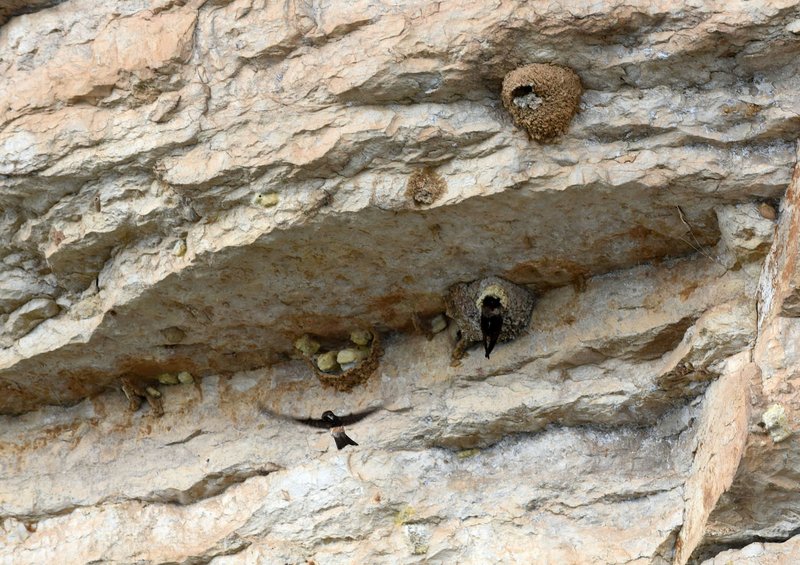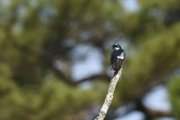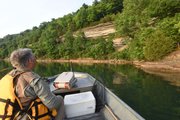Beaver Lake may be the Capistrano of Arkansas. The swallows always return.
Cliff swallows and tree swallows migrate to the lake and to Northwest Arkansas during spring. They're a sight to see while boating on the lake or floating a river. Savvy birders may recognize the rare northern ruffed swallow, or have a bird expert like Joe Neal point one out.
Amazing cliff swallows
• Both sexes build the nest, although the male may initiate construction before he attracts a mate.
• Cliff swallows gather mud from river or lake shores, roadside puddles or seeps, sometimes several kilometers away from their nests.
• Cliff swallows commonly reuse nests from previous years and often spruce up old nests to suit them.
• A pair of swallows can add up to 44 mud pellets to a nest in a 30-minute period.
Source: Birds of North America
"They'll nest in the holes of these bluffs," said Neal, of Fayetteville, as a northern ruffed swallow vanished into the crack of a Beaver Lake bluff. Neal is the author of several books on birds and leads field trips for the Northwest Arkansas Audubon Society.
A morning on Beaver Lake was a lesson in all things swallow with Neal in the boat.
Cliff swallows are the stars of the show at Beaver Lake during summer. They can be seen morning and evening swarming by the dozens, sometimes hundreds, building nests or feeding on flying insects near cliffs that rise from the deep water.
These social birds build communities of nests made out of mud, beneath overhangs on rock walls that rise above the lake. The underside of bridges over rivers are often packed with cliff swallow nests. Each nest looks like a jug or gourd. Nests are roundish with a bottle-neck opening.
Visiting three colonies of cliff swallows at Beaver Lake was the quest of this sunrise boat ride. It became clear in a hurry that the bluffs around Rocky Branch park are a favored habitat for cliff swallows.
Neal peered through binoculars while the boat gently rocked at the base of a cliff 50 feet high, situated one-half mile east of the park.
"There's at least 50 nests here," Neal said. "They're building them all across the overhang."
Cliff swallows flitted about, heavy into their nest building project. Most nests appeared to be half built as birds came and went.
They flew off to pick up a beak full of mud and returned to build their nests one mud pellet at a time.
"There are actually known numbers of pellets like it takes 1,000 beak-fulls of mud to make a nest," Neal said. "Some enterprising graduate student figured that out."
Another bluff 300 yards farther east looked worthy of investigation. Sure enough, more cliff swallows swarmed hither and yon.
"These birds are in the same boat. Their nests are about half built, too," he said.
Once the nests are finished, which will be soon, female swallows lay eggs and hatch young.
"Mamma is probably saying 'hurry up and get that mud up here'," Neal said.
Next it was off to the Mother Lode of cliff swallow nests -- the New York City of cliff swallows, minus Central Park. It's a massive bluff two miles north of Rocky Branch park. Red Bluff, the locals call it.
Turning the boat north led to the towering 80-foot bluff that measures about 100 yards long. Red Bluff is at marker 7 on the lake. Seems every lake and river has a Red Bluff. The one at Beaver is a sight to behold.
Dozens of old nests were seen among new nests that a hundred or more cliff swallows had under construction. The swarms of birds are mesmerizing, hypnotic and soothing to watch as they go about their work.
All three colonies of cliff swallows at Rocky Branch are within easy paddling distance for kayakers and canoe paddlers. Red Bluff is the farthest away, but only a 2-mile paddle. The bluff can be seen from the park. A tour of the three colonies is about a 4-mile trip.
Neal jotted in his field notes the birds we'd seen so far. Cliff swallows, northern ruffed swallows, herons, crows, warblers and more graced his list.
The tally lacked tree swallows, so a cruise into Van Winkle Hollow was in order. Van Winkle Hollow, named for 19th century lumber man Peter Van Winkle, is a long creek arm of Beaver Lake east of Rocky Branch park. The mouth of the hollow is at location marker 6.
Parts of the hollow are tree-swallow heaven with ideal habitat. Dead cedar and hardwood poke from the rippled lake surface. Tree swallows nest in holes of these gnarly trees.
A couple of tree swallows peeked out from dark ovals in the wood as if there were eggs or young inside. Other tree swallows perched on nearby branches over the water.
On shore, two turkey vultures sunned themselves with outstretched wings while roosting high on a treetop.
"These are Arkansas' version of the California condor," Neal said, eyeing the big birds through his field glasses.
Crows cawed as the sun climbed. Ten yards from our boat, a sneaky green heron caught a minnow. That's bacon and eggs to a wary water bird.
The window of swallow-viewing opportunity at Beaver Lake lasts through most of summer, Neal said. About mid-August the swallows head south, like the mythical birds of Capistrano.
Sports on 06/19/2018



